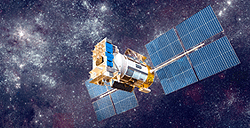For fixed services, communications satellites provide complementary technology to optical fiber. They are also used for mobile applications, such as communications to ships or aircraft, to which it would be impossible to use the cable.
In recent years, satellite communication techniques are used for broadband Internet connections.
A satellite in geostationary orbit is useful for communications applications because ground antennas, which must be pointed at the satellite, can operate effectively without having to be equipped with a satellite tracking system movements, expensive and complicated system to exploit.
Satellites in low Earth orbit are much cheaper to put into orbit geostationary satellites, thanks to their proximity to the ground, requires less signal strength.
Geostationary satellites are necessarily vertically above the equator. Consequently, they are not very interesting at high latitudes in such regions, a geostationary satellite appears very low on the horizon; the link will then be disrupted by the lower layers of the atmosphere.
Even competition from terrestrial optical cables or submarines, the most important application for communication satellites remains international telephony.
Communication satellites are also used to serve as conduits for observational data transmission of low-level flying objects, such as UAVs.
Several geostationary telecommunications satellites are currently used as an aid to users of the GPS and GLONASS and Galileo soon. The technique is known SBAS (Satellite Based Augmentation System), which is a first step to establish a global positioning system satellites.

